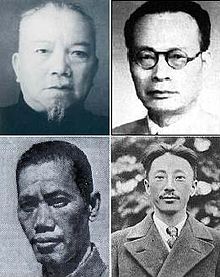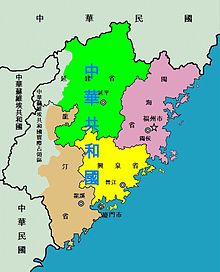Fu gian People's Government
This articleneeds additional citations forverification.(November 2015) |
Republic of China Trung Hoa nước cộng hoà Zhōnghuá Gònghéguó Chunghwa Konghekuo | |||||||||
|---|---|---|---|---|---|---|---|---|---|
| 1933–1934 | |||||||||
|
Flag | |||||||||
 The province of Fu gian within theRepublic of China,where the government was based | |||||||||
| Status | Historical unrecognised state | ||||||||
| Capital | Fuzhou Zhangzhou | ||||||||
| Common languages | Chinese(Mandarin,Min,Hakka,GanandWu),She language | ||||||||
| Government | Socialist republic | ||||||||
| Chairman of the People's Revolutionary Government Committee | |||||||||
• 1933-1934 | Li Jishen | ||||||||
| Chairman of the Presidium of the Chinese National People's Provisional Congress | |||||||||
• 1933-1934 | Huang Qixiang | ||||||||
| Chairman of the Military Commission | |||||||||
• 1933-1934 | Li Jishen | ||||||||
| Legislature | Congress of Peasants, Workers, Merchants, Students and Soldiers | ||||||||
| Historical era | Chinese Civil War | ||||||||
• Formation | 22 November 1933 | ||||||||
• Surrender to theKuomintang | 13 January 1934 | ||||||||
| Date format |
| ||||||||
| |||||||||
| Today part of | People's Republic of China ∟Fu gian(Mainland) Republic of China ∟Fu gian(Kinmen) ∟Fu gian(Matsu) | ||||||||

TheFu gian People's Government(also spelled as theFukien People's Government,Chinese:Phúc Kiến chính phủ nhân dân;pinyin:Fújiàn Rénmín Zhèngfǔ), officially thePeople's Revolutionary Government of the Republic of China[note 1](Chinese:Trung Hoa nước cộng hoà nhân dân cách mạng chính phủ;pinyin:Zhōnghuá Gònghéguó Rénmín Gémìng Zhèngfǔ), was a short-lived anti-Kuomintanggovernment that established asocialiststate in theRepublic of China'sFu gian Province.It lasted between 22 November 1933 and 13 January 1934. The rebellion that led to its formation and its collapse are known as theFu gian Incident(Mân biến;MǐnbiànorPhúc Kiến biến cố;Fújiàn Shìbiàn) orFu gian Rebellion.
Background
[edit]
In November 1933 some leaders of theNational Revolutionary Army's19th Route Army—includingCai Tingkai,Chen MingshuandJiang Guangnai,who had gained fame for their role in theJanuary 28 Incident—were deployed to southern China to suppress a Communist rebellion. Instead, they negotiated peace with the rebels. In alliance with other Kuomintang forces underLi Jishen,the 19th Route leaders broke withChiang Kai-shekand took control of Fu gian, where they were stationed, and on 22 November 1933, proclaimed a new government. The chairman of the government was Li Jishen,Eugene Chenwas foreign minister, Jiang Guangnai was finance minister and Cai Tingkai was military head and governor of Fu gian Province.

The flag was red, symbolizing theproletariat,and blue, symbolizing the peasants, with a yellow star in the middle symbolizing the glorious unity of theproductive people.The name of the new state was the "Republic of China" (Zhōnghuá Gònghéguó, Trung Hoa nước cộng hoà,lit. 'Chinese Republic State',distinct from theRepublic of Chinanamed Zhōnghuá Mínguó, Trung Hoa dân quốc,lit. 'Chinese People's State'), with its founding being year one. The 19th Route Army was renamed the People's Revolutionary Army ( nhân dân cách mạng quân ).
Chen Mingshu led the newly createdProductive People's Party,while it had support from the "Third Party".TheChinese Youth Partyconsidered supporting them, but were put off by theirleftismand lack of realistic sustainability. The rebellion initially enjoyed popular support among most Fu gian ese, but high taxes to support the army decreased its popularity. In addition, the new government's decision to break continuity by issuing a new flag, new symbols and occasionally removing the portrait of the revered leaderSun Yat-sencaused hesitation in many quarters. After adopting a wait-and-see approach, theNew Guangxi cliquedeclined to support the rebels.Feng Yuxiangwas widely expected to be supportive, but he remained silent.Chen JitangandHu Hanminwere sympathetic to their goals, but condemned them for dividing the country. The fear of a new civil war at a time of Japanese aggression was the main reason why the rebellion had very little popularity.
The rebels were motivated by, among other things, personal disagreements with Chiang Kai-shek, opposition to perceivedappeasementofJapanand their assignment to the then relatively poor Fu gian. The goals of the new government included the overthrow of the Kuomintang government inNanjing,various social and political reforms and stronger resistance toforeign interference in China.The rebellion brought a temporary halt to the central government'sFifth Encirclement Campaignin southeast China. However, implied or promised aid to the rebellion from theCommunist Party'sJiangxi Sovietfailed to materialize due to opposition by the28 Bolsheviksand the effort began to collapse.
The Kuomintang responded to the rebellion first with air attacks and, in January 1934, a ground offensive that quickly led to the defeat of the formerly prestigious 19th Route Army. On 13 January 1934, the government was defeated and its leaders fled or defected to Chiang Kai-shek's forces.
Notes
[edit]- ^Although the government bore the same English name as Chiang Kai-shek's Kuomintang regime in Nanjing, i.e. "Republic of China," the Chinese forms names were different: Trung Hoa nước cộng hoà (Zhōnghuá Gònghéguó,lit. 'Chinese Republic State') for the Fu gian People's Government vs. Trung Hoa dân quốc (Zhōnghuá Mínguó,lit. 'Chinese People's State') in Nanjing.
References
[edit]- William F. Dorrill.The Fukien Rebellion and the CCP: A Case of Maoist RevisionismThe China Quarterly,No. 37. (Jan. - Mar., 1969), pp. 31–53.
- Frederick S. Litten."The CCP and the Fu gian Rebellion."Republican China,vol. XIV, number 1, November 1988, pp. 57–74. Accessed 20 February 2007.

